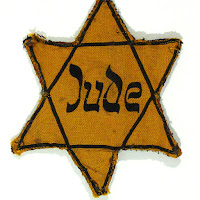In 717, Caliph Umar II ordered that non-Muslims (dhimmi) wear distinguishing marks on their clothing. The Pact of Umar, attributed to his father, had many injunctions against non-Muslims. In 847-861, Caliph Al-Mutawakkil had Christians wear honey-colored patches, on both the front and back of their clothes. In 887, the governor of the Emirate of Sicily had Jews wear special hats and yellow belts.
The Fourth Lateran Council of 1215 said Jews should at all times be denoted by their clothing, and in 1222, Archbishop of Canterbury Stephen Langton ordered English Jews to wear a white band. Distinguishing marks were ordered for Jews by the Synod of Narbonne (1227), by James I of Aragon (1228), and by Alfonso X of Castile (1265).
In 1274, King Edward I in England enacted a second Statute of Jewry, which ordered a badge of yellow felt six inches long by three inches wide to be worn. The yellow color was used in 1315 for the Jews of Granada, in 1321 by Henry II of Castile, and decreed in 1415 by a bull of Antipope Benedict XIII (men wore it on their breast, women on their forehead).
Jews in Venice wore yellow, but in 1528 a special dispensation was given to the physician Jacob Mantino ben Samuel to wear a regular black doctor's cap instead of anything yellow.
In 1710, King of Prussia Frederick William I abolished the mandatory yellow badge in Prussia. This was not an act of charity: he required 8000 thaler (the equivalent of over $75,000 today) from each person who wished to no longer wear the badge.
So what was the deal with Jacob Mantino ben Samuel? I'll explain next time.

